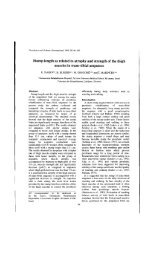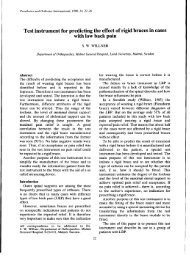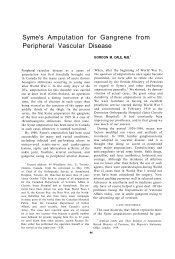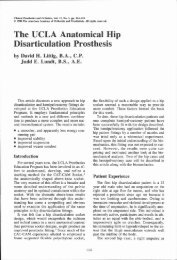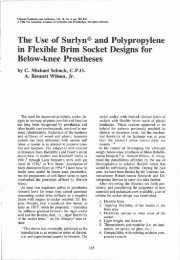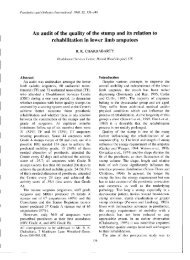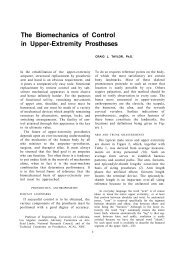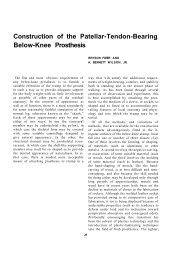Pro-Corn - O&P Library
Pro-Corn - O&P Library
Pro-Corn - O&P Library
Create successful ePaper yourself
Turn your PDF publications into a flip-book with our unique Google optimized e-Paper software.
e disrupted by the same process that destroyed<br />
the natural joint. 6<br />
Figure 1E. AP and mortise views of the ankle at<br />
the same time as 1C and ID.<br />
Conclusions<br />
The major problem of the insensate foot is its<br />
susceptibility. Ataxia, secondary to neuropathy,<br />
imparts abnormal stresses and trauma to<br />
an extremity no longer able to detect injury.<br />
The neuropathy is usually irreversible, so defensive<br />
measures must be taken to control the<br />
process of joint destruction. Well fit ankle and<br />
foot orthoses to support unstable joints and redistribute<br />
weight bearing forces more evenly<br />
are the next line of defense once cast immobilization<br />
has controlled the injury reaction and allowed<br />
healing. Surgery is useful to correct unacceptable<br />
or unstable deformities and relieve<br />
skin pressures.<br />
By understanding the patient's perceptions,<br />
and the pathophysiology of the Charcot foot,<br />
we can provide treatment to prolong the functional<br />
life and avoid the complications of the<br />
insensate foot.<br />
Figure 2. The right foot of same patient in Figure<br />
1. Lateral, oblique, and AP views show midtarsal,<br />
tarsal-metatarsal, as well as interphylangeal<br />
Charcot joint changes—a different pattern of<br />
joint involvement in the same patient. Elements of<br />
bone fragmentation, joint subluxation and dislocation<br />
and bone formation are represented.<br />
References<br />
1<br />
Curtiss, P.H., "Neurologic Diseases of the Foot,"<br />
Foot Disorders: Medical and Surgical Management, Editor<br />
N.J. Giannestras, Lea & Febiger, Philadelphia, 1973, pp.<br />
500-503.<br />
2<br />
Delano, P.J., "The Pathogenesis of Charcot's Joint,"<br />
American Journal of Radiology, 2:56, August, 1946, pp.<br />
189-200.<br />
3<br />
Donovan, J.C. and J.L. Rowbotham, "Foot Lesions in<br />
Diabetic Patients: Cause, Prevention, and Treatment,"<br />
Joslins's Diabetes Mellitus, 12th Edition, Editors A.<br />
Marble, et al., Lea & Febiger, Philadelphia, 1985, pp.<br />
732-736.<br />
4<br />
Herzwurm, P.J. and R.H. Barja, "Charcot Joints of<br />
the Foot," Contemporary Orthopaedics, 3:14, March,<br />
1987, pp. 17-22.<br />
5<br />
Jacobs, R.L., "Neuropathic Foot in the Diabetic Patient,"<br />
Foot Science, Editor M.E. Bateman, W.B.<br />
Saunders Co., 1976, pp. 235-253.<br />
6<br />
Jacobs, R.L. and A.M. Karmody, "The Charcot<br />
Foot," The Foot, Editor M. Jahss, W.B. Saunders Co.,<br />
1982, pp. 1248-1265.<br />
7<br />
Kristiansen, B., "Ankle and Foot Fractures in Diabetics<br />
<strong>Pro</strong>voking Neuropathic Joint Changes," Acta Orthopaedics<br />
Scandanavia, 51, 1980, pp. 975-979.<br />
8<br />
Locke, S. and D. Tarsy, "The Nervous System and<br />
Diabetes," Joslin's Diabetes Mellitus, 12th Edition, Editors<br />
A. Marble, et al., Lea & Febiger, Philadelphia, 1985,<br />
pp. 665-685.<br />
9<br />
Mooney, V. and W. Wagoner, "Neurocirculatory Disorders<br />
of the Foot," Clinical Orthopaedics, 122, January-<br />
February, 1977, pp. 53-61.



